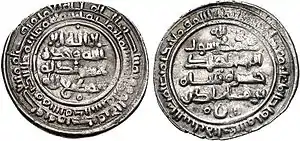Khusrau Shah
Khusrau Shah (also spelled Khosrau Shah, Khosrow Shah, and Khusraw Shah) was the king of the Justanids from 972 to ca. 1004. He was the son and successor of Manadhar.

The words "Khosrow" and "Shah" are both Iranian words that mean "king".
Reign
During the reign of Khusrau Shah, relations between the Buyids flourished; he aided the Buyid ruler Adud al-Dawla in his campaigns by reinforcing him with Daylamite troops.[1] Even during a period when Khusrau Shah was sick, Adud al-Dawla sent one of his physicians named Jibrail III to treat him. Adud al-Dawla married the sister of Khusrau Shah, who bore him Taj al-Dawla (Abu'l-Husain Ahmad) and Diya' al-Dawla (Abu Tahir Firuzshah).[2] Khusrau Shah's brother Fuladh ibn Manadhar was a prominent Buyid officer who held much influence in the Buyid court of Baghdad. Khusrau Shah later died ca. in 1004; the name of his successor is unknown, however, the dynasty continued to rule in Rudbar until the late 11th-century.[1]
References
- Madelung 1975, p. 224.
- Donohue 2003, pp. 86-93.
Sources
- Donohue, John J. (2003). The Buwayhid Dynasty in Iraq 334 H./945 to 403 H./1012: Shaping Institutions for the Future. Leiden and Boston: Brill. ISBN 90-04-12860-3.
- Madelung, W. (1992). Religious and ethnic movements in medieval Islam. ISBN 0860783103.
- Madelung, W. (1975). "The Minor Dynasties of Northern Iran". In Frye, Richard N. (ed.). The Cambridge History of Iran, Volume 4: From the Arab Invasion to the Saljuqs. Cambridge: Cambridge University Press. pp. 198–249. ISBN 0-521-20093-8.
| Preceded by Manadhar |
Justanid king 972-1004 |
Succeeded by Unnamed Justanid ruler |